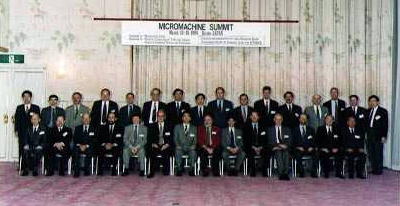|
 |
 |
|
1st Micromachine Summit
March 13-15, 1995
Kyoto, JAPAN
Organized by Micromachine Center
|
|
|
|
|
|
|
|
|
The Micromachine Summit .....
In promoting micromachine, variety of issues and problems arise,
which we have never experienced before, such as effective R&D, the
image of future applications, the creation of new industries and the change
of life-style.
The Micromachine Summit is expected to set a forum in which the
distinguished delegates from around the world discuss and exchange their
views and opinions about these subjects freely, and to help further development
of micromachine throughout the world.
|
|
 |
 |
|
1st Micromachine Summit
Program
March 13-15,1995
YAMASHIRO HALL, THE MIYAKO, Kyoto, JAPAN
|
Monday, March 13
| 15:30 |
|
Registration |
| 18:00 |
- 20:00 |
Welcome Part at HOO HALL |
|
|
|
Tuesday, March 14
| 9:00 |
Opening Remarks
Prof.Nakajima, Chairman of the Summit |
| 9:10 |
Introduction of Delegates |
| 9:40 |
Guest Speech
Ministry of International Trade and Industry |
| 10:00 |
Coffee Break |
| 10:30 |
Country Review
- Australia
- Canada
- France
- Germany
- Italy
- Japan
- The Netherlands
- Switzerland
- The United Kingdom
- The United States
|
|
|
|
Discussion on Topics |
| 13:40 |
Scope of Micromachine Technology - Japan
Prof.Nakajima, The University of Tokyo |
| 14:20 |
Effective R&D - Switzerland
Prof. N.F.deRooij, University of Neuchatel |
| 15:00 |
Combining Multidisciplinary Knowledge - Italy
|
| 16:10 |
Exploiting Application - The Netherlands
Prof. Jan H. Fluitman, MESA Research Institute, University of Twente |
| 16:50 |
Coexistence and Competition with the Conventional Technologies, including
Materials ? U.S.A |
| 17:30 |
New Potential Industries - U.K.
Prof. Howard Dorey, Imperial College |
| 18:10 |
Closing of the discussion on the 1st day |
| 18:30 |
Reception |
Wednesday, March 15
|
Discussion on Topics (continued from the previous day) |
| 9:00 |
Intellectual Property Rights - Canada
Mr. Gordon N.D.Guild Micromachining Technology Center Ltd. |
| 9:40 |
Standardization - Germany
Dr. W.Menz, Forschungszentrum Karlsruhe |
| 10:50 |
Government Role - France
Prof. Daniel HAUDEN, Universtitut des Microtechniques des Franche-comite |
| 11:30 |
International Relations - Australia
Prof. D.G.Beanland, Royal Melbourne Institute of Technology |
| 12:20 |
Lunch |
| 13:50 |
Overall Discussion and the Summary by the Chairman |
| 15:00 |
Closing of the Summit |
|
|
 |
 |
|
Australia
- Prof. D. Beanland,
Royal Melbourne Institute of Technology
- Mr. G. Bates, Powernet Victoria
- Mr. E. Vetter, Hella
Canada
- Mr. G Guild,
Micromachining Technology Centre Ltd.
- Mr. F. Cordeau, Mitel Co.
- Mr. D. Gale, Canadian Microelectronics Co.
France
- Prof. D. Hauden,
UInstitut des Microtechniques des Franche-comite
- Dr. J. Leclerc, Sextant Avionique
- Dr. D. Randet,LETI/CEA
Germany
- Prof. W. Menz,
Forschungszentrum Karlsurhe GmbH
- Mr. C. Ehrlich, Jenoptik GmbH
- Dr. O. Holizinger, Robert Bosch GmbH
Italy
- Prof. P. Dario,
ARTS Lab. Scuola Superiore S.Anna
- Dr. F. Mori, Magneti Marelli Divisione Electronica
- Mr. L. Passaggio, Bieffe Medital S.A.
Japan
- Prof. N. Nakajima,
The University of Tokyo
- Dr. R. Hara,
Seiko Instruments Inc.
- Dr. S. Inaba,
FANUC LTD
- Dr. T. Shimoyama,
OLYMPUS OPTICAL Co.,Ltd.
- Dr. T. Tanaka,
NIPPONDENSO Co.,Ltd.
The Netherlands
- Prof. J.H.J. Fluitman,
University of Twente
- Dr. B. Sastra, Phillips Research Lab. Eindhoven
Switzerland
- Prof. N.F. de Rooij,
University of Neuchatel
- Mr. P. Fischer, Foundation suisse pour la recherche en microtechnique
- Dr. F. Rudolf, Centre Suisse d'Electronique et de Microtechnique SA, CSEM
The United Kingdom
- Prof. H. Dorey,
UK Microengineering Common Interest Group
- Prof. R. Lawes, Daresbury-Rutherford Appleton Laboratory
- Prof. S. Prosser, Lucas Applied Technology Ltd.
The United States of America
- Prof. R.S. Muller,
University of California
- Mr. J. Giachino, Ford Motor Co.
- Dr. B. Hocker, Honeywell Inc.
|
|
 |
 |
1. The l995 Micromachine Summit was held on 13 - 15 March; 29 delegates from 10 countries around the world exchanged views and opinions
about micromachines and their future development.
The aim of this forum was to discuss the future shape of Micromachine technology,
and its contribution to our living standards at the beginning of the 21st
century.
2. At the Summit, 10 vital issues were presented by the delegates and discussed
at length.
The main points raised were-
2.1 Scope
Each country has started from a different technical base, taken a different
technological approach, and used different terminology. To produce micromachines
efficiently, all these technologies should be joined together, and future
work should be in the same direction. The Summit considered the many different
approaches and found that a number had common threads running through their
programs.
2.2 Effective R&D
Much of the Micromachine Technology is at the pre-competitive stage; it
includes a wide range of activities, such as processing, assembly, packaging,
materials and systems construction. Both National and International exchanges
of R&D are important.
2.3 Combining Multidisciplinary Knowledge
The design of a micromachine requires a balanced mix of different disciplines
such as electrical and mechanical engineering, electronics, chemistry,
biology and materials science. In the research and development stages it
is important to exchange information; at the marketing stage exchange between
different industries is important.
2.4 Exploiting Applications
Micromachines promise to blaze a trail through a new frontier.
Although their applications are limitless, there are specific applications
that will improve the welfare of mankind in every country. Full exploitation
requires integration of culture and customs from different professional
disciplines, and an infrastructure that serves small and medium sized enterprises.
2.5 Coexistence and Competition with Conventional Technologies
In addition to creating products that have not previously existed, micromachines
will improve many products that are in production now. This latter production
will account for most of the spread of micromachines in the near future.
A good example is the continued evolution of the microprocessor by giving
it non-electric signal interfaces.
2.6 Potential New Industries
A feature of micromachine technology is that processing and assembly can
be carried out at minute levels of detail, and functional devices implemented.
A new processing industry will emerge, based on the processing and assembly
technologies; the new manufacturing industry will be based on the many
new fields of application.
2.7 Intellectual Property Rights
Technological exchange is the most important issue in advancing micromachine
technology. Intellectual property rights protect the inventor but can impede
the proliferation of technological applications if they are enforced too
strictly by the inventor. The harmonization of the International Intellectual
Property Rights system and the early publication of technical information
are advisable.
2.8 Standardization
Even though micromachine technology is still in the research and development
stage, the process of standardization should be started at the first possible
opportunity, this will support research and development and make the best
use of both investment and personnel. To this end, international harmonization
must be considered as the first principle.
2.9 Role of Government
The establishment of a new technological paradigm for micromachines requires
efforts to be directed across a wide range of technical areas and high-risk,
long term, research and development. As this technology will benefit on
daily lives in every field of human endeavor - industry, society and private
life - vigorous support by Government is justified.
2.10 International Relations
As a new multidisciplinary paradigm, Micromachines require the exchange
of capabilities distributed widely over many countries. The common understanding
that will be achieved through these exchanges will benefit the smooth development
of the world economy in all areas of future trade. The establishment of
regularly scheduled FORUMS was deemed to be one effective means of maintaining
continuous international exchange.
3. After the discussions on these topics were completed, comprehensive discussions
were held, with the following conclusions; -
3.1 To expand discussions on future management and policy, similar FORUMS
should be held on an on-going basis.
3.2 International cooperation in the field of micromachines requires continuous
international exchange to handle a wide range of issues and problems. As
a first step, regular and scheduled FORUMS should be held, organized by
the representatives from each country.
3.3 Standardization through international cooperation is an urgent issue;
the countries involved should begin discussions aimed at standardization
work in international standard organizations such as ISO and IEC.
3.4 Advances in the exploitation of applications, in parallel with research
and development, will accelerate the research itself; we should begin a
study based on cooperation among all the countries involved.
4. This first Summit was held though the efforts of Japan. To ensure the
continued promotion of the Micromachine, the participants have decided
to hold further Summits on an annual basis. The next Summit will be held
in spring,
1996, in Switzerland.
|
|
| |
|


